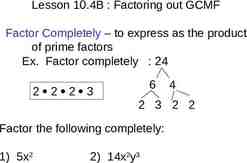November 2016 EMS CE Pediatric Assessment & Respiratory
26 Slides1.66 MB
November 2016 EMS CE Pediatric Assessment & Respiratory Emergencies/ Stroke Review IDPH Site Code: 107200E-1216 Teresa Ehrhardt BSN, RN, TNS
Objectives Upon successful completion of this module, the EMS provider will be able to: 1. Recall the components of the pediatric assessment triangle 2. Given signs and symptoms, identify the patient in respiratory distress or respiratory failure. 3. Discuss the presentation and EMS intervention for a variety of respiratory emergencies including asthma, croup, epiglottitis, and RSV. 4. Create a list of pertinent information to document related to the subject. 5. Actively participate in review of selected Region X SOP’s- Pediatric 6. Actively participate in case scenario discussion. 7. Actively participate in calculating and drawing up pediatric doses of medications. 8. Actively participate in a pediatric code based on your license level 9. Successfully demonstrate airway control in the pediatric population including positioning and intubation. 10.Review stroke documentation components and Primary Stroke Center Prehospital requirements. 11.Successfully complete the post quiz with a score of 80% or better
Pediatric Basics-Review Communication Parents and Caregivers Anatomy and Physiology
Pediatric Assessment Triangle
Airway Management Oxygenation Basic airway management Airway obstruction Airway adjuncts Advanced airway placement
Respiratory Emergencies Click Here Most commonly what EMS is summoned for Recognizing when your patient is in trouble Respiratory distress Respiratory failure Respiratory arrest
Asthma Pathophysiology Assessment Management Status asthmaticus
Croup Toddler with croup Definition Symptom/Causes Diagnosis and Treatment Management
Epiglottitis Epiglottitis Presentation
RSV Baby with Bronchiolitis caused by RSV Definition Symptoms Risk factors Complications Treatments
Pediatric Seizures Fever Infection Hypoxia Epilepsy Head Trauma Hypoglycemia Poison ingestion CNS malformations
SOP’s Routine Pediatric Medical/Trauma Care Pediatric drug assisted intubation Pediatric asthma Pediatric croup/epiglottitis Pediatric respiratory failure Pediatric allergic reaction Pediatric Seizure
SKILL: Pediatric Mega-Code Team Dynamics
SKILL: Pediatric Medication Administration Demonstrate appropriate technique for drawing up medications Demonstrate appropriate medication calculations for the pediatric patient Demonstrate appropriate use of the Broselow Tape
SKILL: Pediatric Advanced Airway Demonstration Each paramedic will demonstrate appropriate technique to intubate a pediatric patient. Pediatric Airway Demonstration
Stroke Review Definition, Screening/Identification, Documentation
Stroke- What is it?
Risk Factors Age/ gender Genetics Smoking Diabetes Cholesterol Hypertension Sedentary lifestyle Obesity Previous stroke Atrial fibrillation
SKILL: Stroke Screening Tools Cincinnati Prehosptial Stroke Scale ACT FAST initiative
DOCUMENTATION MUST HAVESPrehospital Blood glucose check Last known well time (especially if different from time of symptom onset) Cincinnati Stroke Scale
Case Studies 4 pediatric case studies In small groups: Work through each case study Each group will present their case to the class Using Region X SOP’s, the class will explain the prehospital care of each patient. Give a sample radio report using Sequence for Transmission of Patient Information
References Bledsoe, Porter, Cherry. Paramedic Care Principles & Practice 4 th Ed. Brady. 2013. Advocate Condell Medical Center Stroke Patient Information Bookletmaterial copyright 2013 National Stroke Association. http://www.mayoclinic.org/diseases-conditions www.aha.org Region X Standard Operating Procedures, 2014 http:// www.jenonline.org/cms/attachment/2006434567/2028783377/gr1 lrg.jpg Rahm. Pediatric Case Studies for the Paramedic. 2006. Jones and Bartlett.































